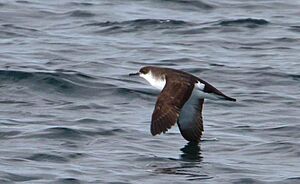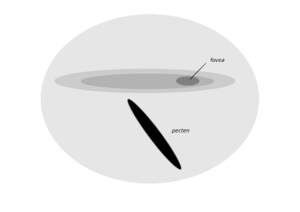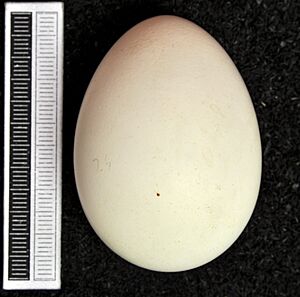Manx shearwater facts for kids
Quick facts for kids Manx shearwater |
|
|---|---|
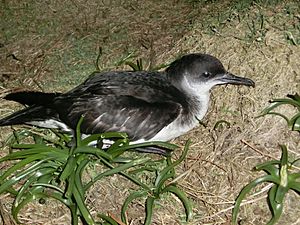 |
|
| On Skomer |
|
| Conservation status | |
| Scientific classification | |
| Genus: |
Puffinus
|
| Species: |
puffinus
|
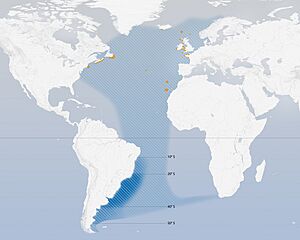 |
|
|
Breeding colonies
(ranges are approximate)Non-breeding visitor |
|
| Synonyms | |
|
Procellaria puffinus Brünnich, 1764 |
|
The Manx shearwater (Puffinus puffinus) is a medium-sized seabird. It belongs to a family of birds called Procellariidae, which are known as "tube-nosed" seabirds. This means they have special tubes on their beaks.
The name "puffin" used to refer to young shearwaters that were prepared as food. Later, the Atlantic puffin got its name because it nests in similar ways. The name "Manx" comes from the Isle of Man, where these birds used to nest a lot.
Contents
About Manx Shearwaters
Manx shearwaters are part of a large group of nearly 100 different seabird species. They have long, narrow wings. They also have a special "tube nose" that helps them smell food far away.
Scientists once thought the Manx shearwater was just one type of bird. But now they think there might be a special kind in the Canary Islands. Many other shearwater species were once thought to be the same as the Manx shearwater. These include the yelkouan shearwater and Hawaiian shearwater.
Some extinct birds, like the lava shearwater, were also related to the Manx shearwater. Even though the lava shearwater was much smaller, DNA shows they were very close relatives.
The Manx shearwater was first described in 1764 by a Danish scientist named Morten Thrane Brünnich. The scientific name Puffinus comes from the old word "puffin." This word was used for young shearwaters that were eaten as a special food.
What They Look Like
The Manx shearwater is about 30 to 38 centimeters (12 to 15 inches) long. Its wings can spread out 76 to 89 centimeters (30 to 35 inches) wide. It weighs between 350 and 575 grams (12 to 20 ounces).
When it flies, it looks like a cross in the sky. Its wings are held straight out from its body. It dips from side to side, almost touching the water with its wingtips. This makes it look like it's changing from black to white. This is because its black top and white underside are shown as it flies low over the sea.
Their Calls
Manx shearwaters are usually quiet when they are out at sea. But at night, when they visit their nesting burrows, they become very noisy. They make loud, harsh sounds like croons, howls, and screams.
The male birds have clearer, higher-pitched calls than the females. When a pair calls together, you can easily hear the difference. Their night calls are so strange that some people have called them "Devil Birds." This is because their sounds can be quite spooky if you don't know what they are.
Female shearwaters can recognize their mate's voice. But they don't need to recognize their chicks' voices. This is because any chick in their burrow is likely their own.
How They See
Manx shearwaters have special eyes that help them live their lives. Like other tube-nosed seabirds, they have a long, narrow area in their eye's retina that is very sensitive to light. This area helps them spot things in a small area below and around their beak. This is useful for finding food near the water's surface as they fly low.
Since they visit their breeding colonies at night, they also have good night vision. The lens in their eye does most of the work to focus light. The outer part of their eye, called the cornea, is quite flat. This is different from birds like pigeons, which have a very curved cornea.
Even though they have adaptations for night vision, it's not perfect. These birds probably also use their sense of smell and hearing to find their nests in the dark.
Where They Live and Travel
The Manx shearwater spends all its time at sea. It usually flies within 10 meters (33 feet) of the water's surface. They nest in burrows on small islands and only visit these burrows at night.
Their main nesting places are in the north Atlantic Ocean. You can find them in the United Kingdom, Ireland, Iceland, the Faroe Islands, and other places. The biggest colonies, with over 300,000 pairs, are on islands off Wales, Scotland, and Northern Ireland.
During the breeding season, birds often fly long distances to find food. They can travel up to 1,500 kilometers (930 miles) from their nests. For example, some birds from Ireland fly all the way to the Mid-Atlantic Ridge to feed.
From July to March, these birds leave their breeding colonies. They migrate to the South Atlantic, mainly off Brazil and Argentina. This journey can be over 10,000 kilometers (6,200 miles) long. Young birds make this first long trip without their parents. A 50-year-old bird might have flown over a million kilometers (600,000 miles) just on migrations!
Manx shearwaters are amazing flyers. They can find their way back to their burrows even when released hundreds of kilometers away, even if they are inland.
Their Life and Habits
Manx shearwaters are known for living a long time. One bird found on Copeland Island in Northern Ireland was at least 55 years old in 2003. It was the oldest known wild bird at that time!
These birds like to be in groups. You can see many of them together from boats or headlands, especially during their autumn migration. They are quiet at sea, but their breeding colonies are full of loud calls at night.
Reproduction and Life Cycle
Shearwaters return to their breeding colonies in March. Females often leave for a few weeks before laying their eggs in early May. Males usually go back to the same colony where they were born. But about half of the females might choose a different place.
They nest in burrows, which are often old European rabbit holes. Shearwaters can also dig their own burrows or use holes under rocks. They often use the same burrows year after year.
They lay only one white egg. The egg is about 61 by 42 millimeters (2.4 by 1.7 inches) and weighs about 57 grams (2 ounces).
What They Eat
Manx shearwaters eat small fish like herring and sand eels. They also eat crustaceans (like shrimp) and cephalopods (like squid). They catch food from the surface of the water or by diving underwater. They usually hunt alone or in small groups.
These birds can smell food from many kilometers away. They can detect things like dimethyl sulfoxide, which is released when tiny ocean plants are eaten by krill. They fly across the wind until they find a scent, then follow it upwind to find the food.
Rafting Behavior
Manx shearwaters often gather in large groups on the water. This is called "rafting." They do this near their Skomer Island breeding colony before and after visiting their chicks. These groups can have more than 10,000 birds!
Rafts move closer to the island at night and further away in the morning. This creates a "halo" effect, meaning no birds are close to the island during the day. This behavior might help them wait for dusk while staying safe from predators.
Dangers and Health
Because Manx shearwaters are not very good at moving on land, they can be easily attacked by large gulls like the great black-backed gull. Birds of prey such as the peregrine falcon also hunt adult birds.
Rats and cats are a big problem on islands where they are found. A large shearwater colony on the Calf of Man was destroyed by rats that came from a shipwreck a long time ago. European hedgehogs also eat their eggs if they are introduced to an island. Even Red deer have been seen killing and eating young shearwaters on some islands. This might be because the deer need extra calcium.
Manx shearwaters can get feather lice. These tiny insects eat feathers or blood. Their nests can also have shearwater fleas. Sometimes, they get a disease called puffinosis. This is a viral disease that causes blisters and movement problems in young birds. It can be very serious.
Conservation Status
There are about 350,000 to 390,000 breeding pairs of Manx shearwaters in Europe. This makes up about 95% of all the Manx shearwaters in the world. Even though their numbers seem to be slowly going down, the decrease is not fast enough to be a major concern for conservation. Because there are so many of them, the International Union for Conservation of Nature says they are of least concern.
In the northern parts of their range, their numbers are stable and even growing. However, human activities are affecting populations in the Macaronesian islands in the eastern Atlantic Ocean. For example, young birds can get confused by bright artificial lights and crash.
In the Faroes, about 1,000 to 5,000 chicks are legally taken for food each year. Also, animals like rats and cats that are brought to islands can cause problems. But if these animals are removed, the shearwater populations can recover.
In Culture
The large chicks of the Manx shearwater are very oily from their fish diet. People have eaten them since ancient times. They are easy to take from their burrows. In the 17th century, as many as 10,000 birds might have been taken each year from the Calf of Man.
The strange, loud calls of nesting shearwaters at night have led to stories about supernatural beings. Some places where they nest, like Trollaval on Rùm and Trøllanes in the Faroe Islands, are named after trolls. This is because of the eerie sounds the birds make at night.



